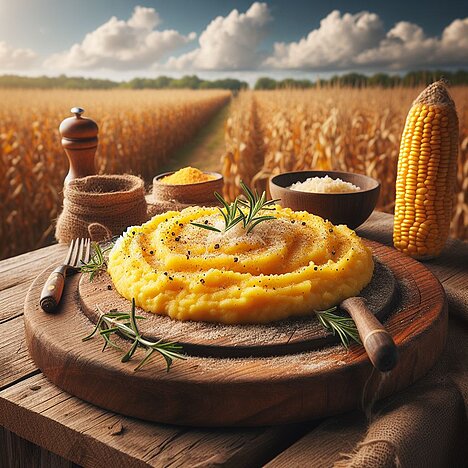Polenta

What is polenta?
Polenta is a corn product made from the finely ground endosperm of the corn kernel. It is rich in carbohydrates, fiber, vitamins and minerals. Among other things, polenta contains vitamin A, B vitamins, iron, zinc, magnesium and potassium. Polenta is also gluten-free and therefore suitable for dogs with a gluten intolerance or allergy.
What are the benefits of polenta for dogs?
Polenta can have several health benefits for dogs if it is fed in moderation. Firstly, polenta can be used as a light diet if your dog suffers from gastrointestinal problems. Polenta is easy to digest and binds excess fluid in the intestines. Secondly, polenta can be used as a source of energy if your dog is very active or underweight. Polenta provides quickly available carbohydrates that give your dog strength. Polenta can also help your dog's digestion as it contains fiber, which stimulates intestinal movement and improves the consistency of faeces.
What are the disadvantages of polenta for dogs?
However, polenta also has some disadvantages for dogs that you should be aware of. Firstly, polenta can lead to obesity if it is fed too often or in too large quantities. Polenta has a high glycemic index, which means that it causes your dog's blood sugar level to rise and fall quickly. This can lead to food cravings and obesity. On the other hand, polenta can lead to allergies or intolerances if your dog is sensitive to corn. Corn is one of the most common allergens in dogs and can trigger symptoms such as itching, skin rashes, diarrhea or vomiting.
How do I prepare polenta for my dog?
If you want to feed your dog polenta, you should follow some tips to protect your dog's health. Here are some tips:
- Only use high-quality polenta without additives such as salt, sugar or spices.
- Cook the polenta in water or unsweetened milk according to package instructions or a little longer until it is very soft.
- Only feed your dog a small amount of polenta as a side dish to his normal food or as a treat between meals.
- Make sure your dog always has enough fresh water available.
- Observe your dog after eating for possible signs of allergy or intolerance.
Polenta can be a tasty and nutritious treat for dogs if prepared correctly and fed in moderation. Polenta can help your dog with gastrointestinal problems, provide energy and aid digestion. However, you should make sure that your dog does not eat too much polenta, as it can otherwise lead to obesity or allergies.
If you notice any signs of hypersensitivity or poisoning in your dog, you should see your vet immediately. We are not a substitute for a vet, but we try to be as accurate as possible. Every dog reacts differently and we recommend you get a second opinion or consult your vet if in doubt.
Stay healthy and take good care of your four-legged friend!😊